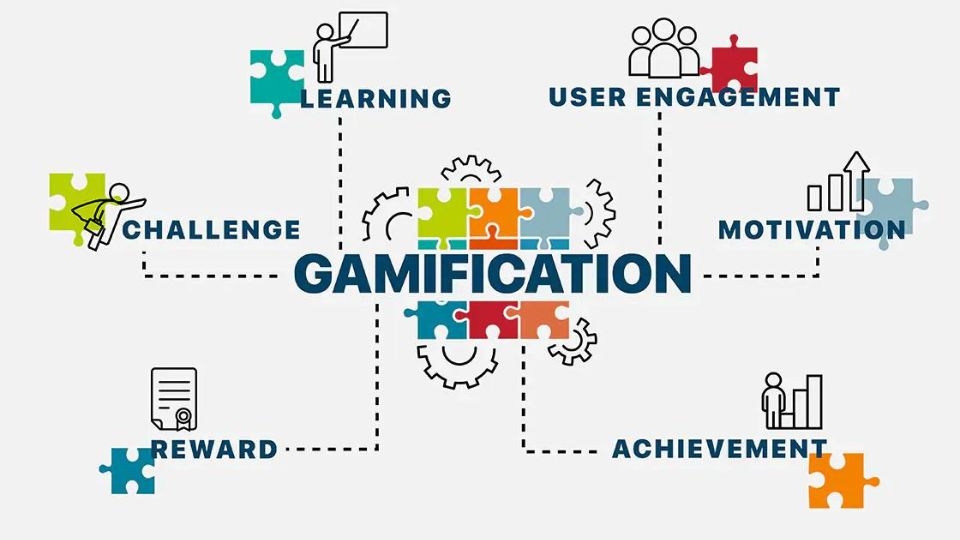Gamification là gì? Đây là thuật ngữ để chỉ xu hướng quản lý mới được xuất hiện rất nhiều dạo gần đây. Theo đó, các doanh nghiệp này sẽ ứng dụng game hóa vào các trang web trực tuyến để thu hút người tham gia. Nó được ứng dụng rộng rãi trong các lĩnh vực khác nhau nhưng phổ biến nhất là marketing.
Gamification là gì? Đây là một xu hướng quảng bá quen thuộc được nhiều doanh nghiệp ứng dụng trong chiến dịch thu hút khách hàng. Tuy nhiên, không phải ai cũng hiểu rõ bản chất cũng như nguyên lý hoạt động và lợi ích mà Gamification mang lại. Trong bài viết này, Ausun sẽ giúp bạn có cái nhìn chi tiết và tổng quan nhất về vấn đề này. Cùng tìm hiểu ngay thôi!
Gamification là gì?
Gamification là quá trình ứng dụng game vào trong hoạt động marketing, giáo dục hoặc quản lý. Đây là giải pháp nâng cao độ nhận diện, thu hút khách hàng hoặc tăng năng suất làm việc,… Thông thường, game hóa thường được ứng dụng trong môi trường phi trò chơi như website bán hàng, trang mạng trực tuyến hoặc mạng nội bộ doanh nghiệp. Mục tiêu mà nó là hướng tới việc tăng tương tác giữa các đối tượng người dùng khác nhau với doanh nghiệp.

Về cơ bản thì đây là quá trình áp dụng tính năng và quy luật của trò chơi vào các nền tảng trực tuyến của doanh nghiệp. Theo đó, họ có thể tạo ra những nhiệm vụ đơn giản để khách hàng thực hiện. Gamification khuyến khích người dùng tham gia vào những trò chơi đó để giúp thương hiệu đi sâu vào tâm trí khách hàng hơn.
Trên thực tế, có nhiều đơn vị đã ứng dụng thành công giải pháp này như Shopee (Đăng nhập nhận xu mỗi ngày, lắc xu, trồng cây kiếm xu), Starbucks (Chiến dịch tích lũy đơn hàng nhận ly miễn phí),…
Gamification được xem như một giải pháp tuyệt vời giúp doanh nghiệp cạnh tranh với các đối thủ khác trên thị trường. Bên cạnh đó, nó cũng góp phần tạo nên nét độc đáo, khác biệt của các thương hiệu với nhau. Đồng thời, nó có thể xây dựng được niềm tin và lòng trung thành từ phía khách hàng.
Cơ chế hoạt động của Gamification là gì?
Thật ra, nguyên lý căn bản của cách làm này chính là dựa vào cơ chế trò chơi để tạo hứng thú nhằm thu hút sự chú ý của khách hàng. Nói đơn giản là tích hợp trò chơi vào các nền tảng trực tuyến chính của đối tượng muốn viral để phục vụ mục đích kinh doanh của doanh nghiệp.
Sự thành công của Gamification đến từ 3 yếu tố động lực chính. Nó được trình bày dựa trên việc khai thác các yếu tố như lòng tin khách hàng, may mắn, nhu cầu hưởng thủ,… và đặc biệt là tránh khai thác giá trị vật chất. Theo đó, 3 yếu tố tạo nên cơ chế hoạt động của nó bao gồm:

- Mục đích: Khai thác sự hiếu kỳ, mong muốn, cảm xúc và sự trông đợi của khách hàng.
- Quyền lợi: Người tham gia được làm chủ quyết định có tiếp tục chơi hay không. Đồng thời, họ được tự ý đưa ra lựa chọn cho riêng mình khi tiếp tục chơi.
- Mức độ trải nghiệm: Người chơi cần được làm chủ trò chơi vậy nên game càng đơn giản càng tốt. Điều này giúp họ không có cảm giác ức chế hoặc nản lòng khi không chinh phục được nó.
Một chiến dịch Gamification thành công là phải chạm đến được cảm xúc của đối tượng mục tiêu. Khi tương tác với mô hình game hóa này, họ sẽ luôn nhận được kết quả tích cực. Nếu gắn bó lâu với trò chơi, họ có thể đạt được nhiều thành tựu mới giúp nâng cao vị trí của mình trên bảng xếp hạng. Đây là điểm cốt lõi vì nó đang kích thích đến tham vọng và ham muốn chinh phục thử thách của con người.
Tại sao cần áp dụng Gamification trong Marketing
Mục tiêu chính khi áp dụng Gamification chính là tạo sự hiếu kỳ của khách hàng. Nếu như người chơi cảm thấy hài lòng, họ có thể tăng số lần tương tác với doanh nghiệp. Thay vì hình thức quảng cáo truyền thống một chiều thì cách này có thể mang đến nhiều trải nghiệm thú vị hơn.
Nếu bạn còn mơ hồ và chưa thấy được tầm quan trọng của điều này thì có thể tham khảo 5 lý do nên áp dụng Gamification mà chuyên gia đã chỉ ra như sau:

- Game hóa giúp doanh nghiệp kết nối với khách hàng thông qua những tương tác dài hạn.
- Khách hàng sẽ nhận được những trải nghiệm thú vị khi tham gia trò chơi của thương hiệu, từ đó tăng sự liên kết và thúc đẩy nhu cầu mua hàng của họ.
- Tạo động lực để khách hàng tham gia các chương trình quảng bá website hoặc ứng dụng của doanh nghiệp như một phần trong cuộc sống của họ. Đồng thời, có thể thu hút khách hàng tiềm năng thông qua sự giới thiệu của khách hàng cũ.
- Giúp chuyển đổi khách hàng tiềm năng thành khách hàng trung thành thông qua sự gắn bó với các trò chơi.
- Nâng cao trải nghiệm khách hàng, tạo sự độc đáo, khác biệt của doanh nghiệp so với các đối thủ cạnh tranh.
Rủi ro khi áp dụng Gamification là gì?
Trên thực tế, game hóa rất hữu ích và mang lại nhiều giá trị cho doanh nghiệp. Vì nó tác động thẳng đến tâm lý của con người. Tuy nhiên, tại sao hiện nay vẫn còn nhiều nơi dè chừng biện pháp này và chưa áp dụng nó vào hoạt động? Nguyên nhân bởi vì những yếu tố rủi ro sau:

- Quá trình game hóa cần được xây dựng dựa trên việc hiểu rõ các đối tượng mục tiêu. Nếu như việc thiết kế trò chơi quá kém không đáp ứng được mong muốn khách hàng có thể gây ra tác dụng ngược. Trải nghiệm của người chơi có thể bị ảnh hưởng và từ đó họ có thể mất đi hứng thú với thương hiệu. Điều này sẽ làm lãng phí thời gian và tiền bạc của doanh nghiệp trong khi hiệu quả đạt về là con số 0.
- Trò chơi trực tuyến rất dễ gây nghiện nhất là những game nhập vai hoặc cờ bạc. Điều này gây ra rủi ro các thương hiệu dùng Gamification để tạo ra mục đích thương mại. Từ góc độ của người dùng, họ sẽ cảm thấy bị lừa dối và thao túng. Do đó, doanh nghiệp cần lựa chọn kỹ game để triển khai sao cho vừa thu hút nhưng không được gây nghiện.
Những điều cần chú ý khi áp dụng Gamification
1. Hiểu rõ khách hàng mục tiêu
Đây là vấn đề cốt lõi mà nhiều doanh nghiệp đau đầu khi bắt tay vào thực hiện chiến dịch marketing theo Gamification. Bạn cần phải xác định đúng đối tượng mục tiêu để xây dựng trò chơi sao cho phù hợp nhất. Điều này cần được xác định dựa trên nhiều yếu tố khác nhau như: đối tượng khách hàng, sở thích của khách hàng, vấn đề mà họ quan tâm, mục đích của chiến dịch,… Bạn có thể dựa vào 3 tiêu chí sau để xác định khách hàng của mình:

- Giới tính: Nam hay nữ?
- Độ tuổi: Thế hệ Z (1995 – 2000) là những người cá tính, thích săn sale, hàng giảm giá, thích nhận quà. Thế hệ Y (1981 – 1996) nhóm người quan tâm tới chất lượng và thương hiệu. Trên 45 tuổi là thế hệ không quan tâm đến thương hiệu nhưng rất quan tâm đến chất lượng.
- Khu vực sống của khách hàng: Ở thành thị hay nông thôn? Chất lượng sống như thế nào?
2. Xác định đúng mục tiêu thực hiện trong chiến dịch Gamification
Để không thực hiện chiến dịch một cách tự phát hay cảm tính, bạn cần xác định mục tiêu hướng tới khi sử dụng Gamification là gì. Một vài doanh nghiệp đã áp dụng thành công nhờ xác định hướng đi đúng cho chiến lược Gamification là:

- Dùng Gamification để giải quyết hàng hóa tồn kho
Nếu doanh nghiệp của bạn đang có một lượng lớn hàng tồn mà không biết phải giải quyết thế nào thì có thể áp dụng Gamification. Bạn có thể dễ dàng nhận thấy điều đó ở các ngành hàng thời trang hay thức ăn nhanh.
Hiện nay, chiến dịch nổi bậc nhất trong việc ứng dụng game hóa chính là “Quay giá nào mua giá nấy”. Có nghĩa là với sản phẩm A, người chơi quay được 100.000đ thì sẽ trả 100.000đ, nếu quay được 200.000đ thì mua với giá 200.000đ. Tất nhiên là bạn có quyền quyết định có nên mua sản phẩm hay không.
- Dùng Gamification để thu thập thông tin người tiêu dùng
Điều này xảy ra phổ biến ở những doanh nghiệp muốn tiếp cận và hiểu rõ khách hàng của mình. Theo đó, khách hàng sẽ cung cấp một vài thông tin của họ đổi lại doanh nghiệp sẽ tặng một phần quà. Nó khá giống với mô hình điền form nhận tài liệu học tập mà sinh viên hay sử dụng. Đây là mối quan hệ win – win đôi bên cùng có lợi nên nếu nhận được quà tặng tương xứng thì họ chắc chắn sẽ làm.
- Tăng độ nhận diện thương hiệu
Nếu như khéo léo lồng ghép tương tác với doanh nghiệp thông qua trò chơi, bạn có thể làm cho khách hàng nhớ về thương hiệu của mình lâu hơn. Thông thường, họ sẽ tích hợp các yêu cầu like, share hay comment như một điều kiện để tham gia trò chơi.

Ví dụ như vòng quay Shopee chỉ giới hạn 1 lượt quay 1 ngày nhưng nếu bạn chia sẻ ứng dụng này đến 1 người bạn của bạn thì sẽ nhận thêm 1 lượt quay nữa. Điều này sẽ giúp thương hiệu của bạn được tiếp cận với nhiều người hơn mà không cần bất kỳ chiến dịch quảng bá nào.
- Dùng Gamification để tăng doanh số
Đây có lẽ là mục tiêu mà nhiều doanh nghiệp hướng đến nhất. Tuy nhiên, để tăng doanh số thì bạn cần phải thực hiện nhiều chiến dịch khác nhau trong đó có việc dùng Gamification. Hãy đảm bảo thiết lập các trò chơi thú vị, tặng quà hợp lý và linh động phần thưởng để người tham gia không thấy nhàm chán.
Đồng thời, hãy phân bố nhân lực hợp lý để kịp thời giải quyết những thắc mắc và yêu cầu của khách hàng tránh việc ôm đồm quá nhiều việc. Nhìn chung, bạn cần hoạch định một chiến dịch rõ ràng và toàn diện thì mới có thể theo đuổi được mục tiêu này.
3. Thiết lập phần thưởng hấp dẫn
Đây là yếu tố quan trọng quyết định sự thành bại của chiến lược Gamification. Tâm lý của khách hàng bao giờ cũng mong muốn nhận được những món quà giá trị hoặc phần thưởng. Dù là nhỏ nhưng đó như một sự khích lệ giúp họ hài lòng hơn. Những quà tặng có thể là mã giảm giá, voucher khuyến mãi hoặc phần thưởng đặc biệt,…

Những lưu ý khi thiết kế phần thưởng trong trò chơi là:
- Phần thưởng phải đi kèm với chất lượng để tạo sự tin tưởng cho khách hàng.
- Thể lệ nhận quà nên được rõ ràng, minh bạch, tuyệt đối không nhập nhằng, dây dưa.
- Nên có voucher hoặc mã giảm giá để giúp kích thích mua hàng.
- Không nên dùng những phần thưởng quá lớn, không đề cao giá trị vật chất mà nên tìm hiểu mong muốn của khách hàng như giảm giá, miễn phí ship,…
4. Cố gắng đơn giản hóa trò chơi
Bạn nên nhớ những trò chơi ở đây chỉ phục vụ mục đích marketing. Vì thế, nên thiết kế nó càng đơn giản thì càng tốt. Một trò chơi quá phức tạp có thể sẽ tăng hứng thú với người dùng nhưng cũng đồng thời gây ra trở ngại lớn đến những trải nghiệm của họ. Nếu người chơi không thể hiểu trò chơi thì coi như đó thất bại của chiến dịch.
Kết luận
Trên đây là những thông tin để trả lời cho câu hỏi Gamification là gì. Đây là một giải pháp marketing có tác động to lớn trong việc nâng cao độ nhận diện và sự kết nối giữa doanh nghiệp và khách hàng. Nếu bạn muốn xây dựng thương hiệu theo hướng tích cực để quảng bá đến người dùng thì hãy áp dụng nhé. Bên cạnh đó, đừng quên cân nhắc rủi ro và khảo sát kỹ các yếu tố liên quan để thực hiện chiến dịch thành công.










































